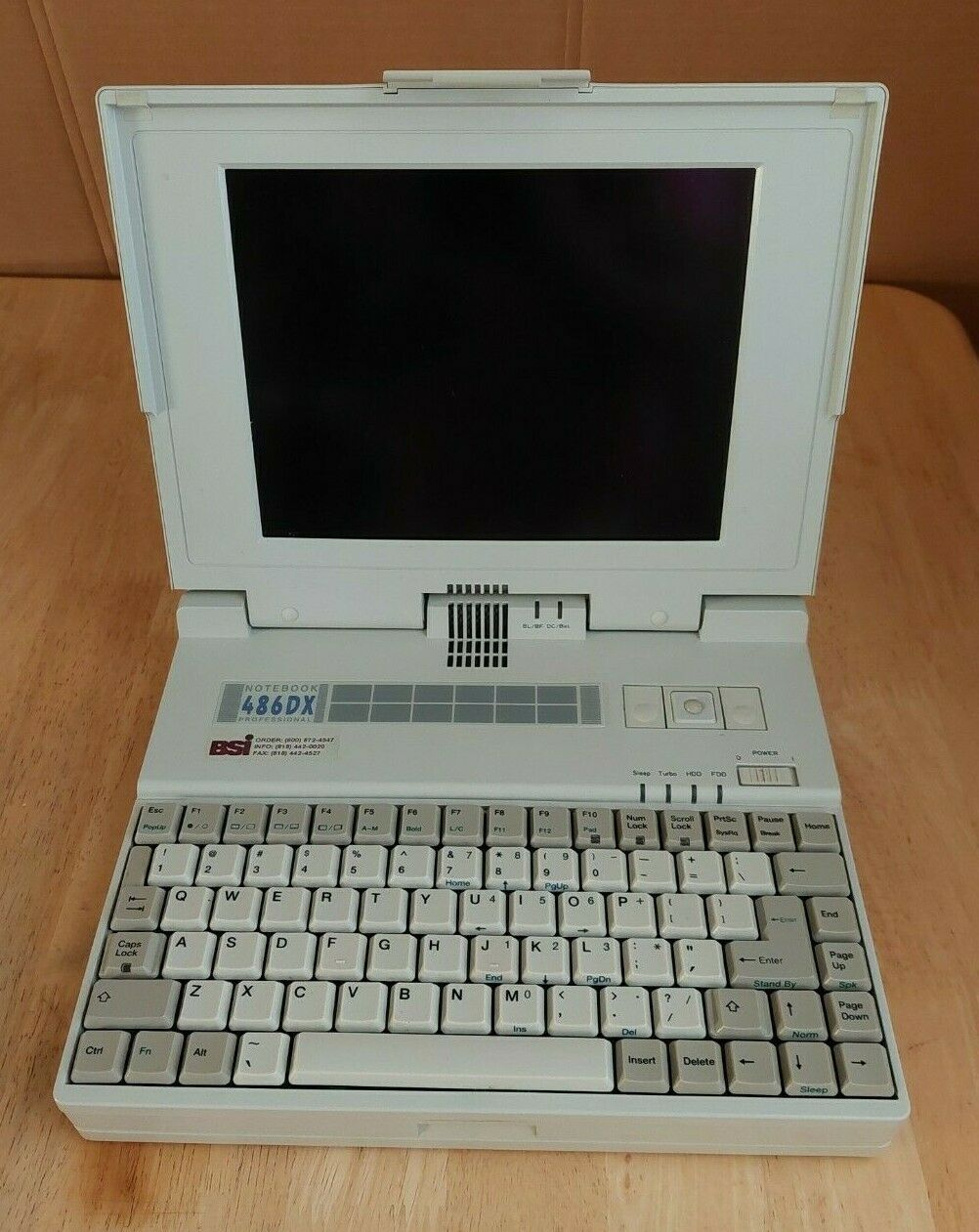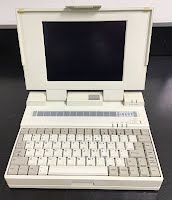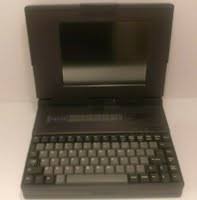

| NanTan "Notebook" 3500 Series | |||||||||||||||||||||||||||||||||||||||||||||||||||||||||||||||||||||||||||||||||||||||||



Basic Specifications
Versions It seems NanTan tried to milk this platform for all it was worth. There was the FMA3500, FMA3500SX, and at least TWO versions of the FMA3500C - which was a color version. The primary distinction was the regular 3500 was monochrome, and used the standard NTC 4-pin power supply connector, same with the 3500SX which is less common and has it's system bus slowed down to 25MHz, and then there's the 3500C which came in both DTSN and Active Matrix color versions. The FMA3500 and FMA3500SX is a monochrome laptop with symetrical hinges, a 9.4" Casio LCD display panel (STN), a four prong power supply jack that's sometimes quite hard to find power supplies for, and the vent does not extend to the screen. Also, the battery is not vented either. I've seen these come in both a more Compaq Off-White, and the darker, more NEC-like, gray color. It seems when NanTan designed these, they were trying to rip off the look of the early Compaq LTE and Toshiba Sattelite machines, and then later tried to "Modernize" by 93' or so by changing the color to gray, or offering it as an option to prospective badge manufacturers. The FMA3500C came in TWO versions - both color - DSTN, and Active Matrix TFT. They differ in that I have seen them both come with a trackball, and without a trackball. The trackball models have the "486 DX Professional" logo shifted to the left side of the panel above the keyboard, and then a trackball put in the space where that logo originally existed. It's a 2 button, PS/2 based, Microsoft compatible trackball with a pea-sized ball in it that can be removed by taking the top off the laptop and then prying a cover off of it. These also came in gray. The hinges changed on these two with more of a 60/40 combination, with a wider hinge leg on the left side to make room for the extra cables needed for a 2 or 3 connector DSTN or TFT color screen. The DSTN panel was a Sanyo Sanyo LCM-5331-22NTK 9.4" color LCD panel. It has okay-ish color, though it looks a little washed out. They tend to age in a way the colors are a little inconsistant and viewing angle is a little funky, plus they ghost quite a bit when playing high speed games. The Active Matrix version seems to be far more rare, and it appears it could either have a SHARP LCD, or possibly even an NEC NL6448AC30-12 - which was one of the industrial versions of the LCD used in the original NEC UltraLite Versa series, this laptop's peer and competitor. All versions feature two serial ports, one parallel port, a PS/2 on/off switch, a 1/8" phono jack for a external numeric keypad, a PS/2 port for a mouse (even with the trackball), VGA connector, and a pop-off "expansion" port on the back that might be ISA compatible (if I can figure out the pinout) - this was intended for a screw on docking station that replaced the battery when in use and gave the computer 2 ISA Slots. The battery is a 12V NiCAD battery that thumbscrews to the back and can give about 1.5 Hours of battery life per most PC-Magazine reviews. You can actually replace it with a similar battery pack today as it's modular and has a molex connector (at least on the nanTan FMA3500s I've had).User-Upgradable Components THE FMA3500 series uses standard desktop components (kinda' sorta') for the Hard Drive, Floppy Disk drive, Memory, and CPU. However, each one has some limitations you should be aware of before proceeding to top it out with a Am486 DX4-100, 32MB of RAM, and a 80GB ATA-133 HDD. CPU Upgrades - I have not explored far enough yet but I have seen these laptops came in both 25MHz and 33MHz system bus speeds. There might be a jumper or dipswitch somewhere tochange it but it is entirelu possible NanTan Hard-Wired the CPU on these to a specific speed as well. The only CPUs that will work for sure are everything from the Intel 486 DX2-66 and below as it's a Socket 1 montherboard inside and it likely does not have a voltage controller for the CPU, meaning it only runs 5v (486 DX2 and older) CPUs with Write Through Cache only. If you got a voltage adapter interposter, a 486 DX4 series 3.3v CPU would be possible, but there's not really much benefit because a lot of the perks of the DX4 era laptops such as sound and in most cases with this model, color screen, would not be available without extensive modifications. Memory Upgrades - Every FMA3500 series system I have seen uses 30-pin SIP Memory, and usually they have 4096 or 7808K (4 or 8MB) of RAM. SIP memory is electronically identical to 30 pin SIMMS, so you might, if you are handy with a soldering iron, be able to remove the SIP sockets and put SIMM sockets in there place to allow for more memory upgrade options. I have been told by someone on Vintage Computer Federation forums that this computer is capable of up to 32MB of RAM on 30 pin SIPs. That said, a suggested high end update would be to replace all the SIP slots with 30 pin SIMM Slots. I have also heard that you could, at least in theory, buy 4 30 pin SIMM slots and plug the slots into the SIP slots as a "converter", but I'm a little unsure about clearance, especially on the FMA3500C which uses a much fancier, bigger, video card that hangs over the top of the memory slots. Hard Disk Upgrades - While the hard disks used are standard 3.5" IDE HDD, there is a couple caveats with this. The first one is the power connector. The drives NanTan uses are hard disk drives designed with a second 3-pin power connector to the left of the 40 pin IDE header. However, one can put a regular 4-pin Molex in by wiring the red and yellow wires apropriately, and bridging the ground to the two middles from the black wire. This works perfectly and gives a bootable drive, though the ribbon cable might be a bit tricky to get back into place. Another limitation I found is it will not handle any ATA hard drives above ATA-66 standard. Basically, my Seagate 8GB will work, but it won't detect my newer 20/40/60GB ATA-100/133 drives that I use, they just give an error of "Hard Disk Initialization Failure", and SATA experiments don't even detect the drive and give an error "Hard Disk not Functioning or Not Present". Have not tried CF Cards yet. This was an earlier 486 Design using an older BIOS (Award BIOS similar to what Creeping Net #1 used on it's Zeos motherboard), so the 528MB HDD limit (CHS is 1024, 16, 63) applies here, and it does not like to play nice. Your best bet with this laptop MIGHT be to get a 8GB DOM or 8GB CF Card with an IDE Converter, and then crimp on your own molex power connector, use MAXBLAST for the Dynamic Drive Overlay, and then you could have a really nice, (somewhat) portable WIndows 3.1 machine. Floppy Drive Upgrades - I have not tried it but I would think a GoTek would be easily doable because the floppy drive uses all of the same wiring as a regular, desktop floppy drive. You also can use 720K Floppy drives in here, though I'm not sure why anyone would want to. No PCMCIA, What Other Expansion Can Be Done? - So the FMA3500 series does NOT come with a PCMCIA Socket. This means you will not be able to use Network Cards or WiFi Cards in the traditional way for laptops/notebooks. That said, there IS an expansion module for the back of the laptop which I'm not quite sure what the pinout is. Serial/Parallel solutions could work too (which I bring up later). That said, there is an expansion port in the back that I believe was used with the "Docking Station" solution they had for these laptops. It might be ISA Compatible, and if such, might be possible to add an ISA "Breakout Box" of sorts to the back of the machine to allow further expansion. So it's not exactly the best candidate due to limited expansion andn some pretty low-level work you may have to do to install upgrades you want. But it's not a bad little laptop either, it's just an older design so it's a little trickier to setup.Common Low Level Issues CMOS Battery - These use the "Varta" style CMOS Battery, the horrible little barrel battery that tends to leak and eat up parts of the motherboard. This was the case with my second FMA3500C (the one I have now). The verdict is out on what is really the best solution to this. Some people cut the battery, which means you have to input the CMOS Settings every time (I ALMOST have the CHS for the original Maxtor HDD memorized as a result). Currently I'm using a Cr2302 coin cell style battery in a shrinkwrap package used for Dell Latitude E-series laptops and it's working great. It keeps the settings, and I don't see or hear anaything bad as a result, so I'm going to use and monitor it for the time being. There's also a CMOS Clear Jumper near where the Varta was that just breaks connection to the system to clear. Regular Battery - The battery pack on the FMA3500 series is a NiCad 12V 2500mAH battery pack. These are actually vERY easy to replace as the battery pack itself is just a regular "C" cell 8 cell NiCad battery pack attached to the inside of the screw-together battery pack with a molex connector. It may even be possible to stack a BMC and put a modern LiIon battery in there for enhanced runtime. It seems to get about 30 minutes out of a regular 12V NiCad that's very old, so it's possible to get these to run under battery power still, so there's a real plus for people seeking portability. Trackball - The trackball on these tends to be pretty dirty. Granted, it is not the most ergonomic solution ever created, but it works quite well when cleaned up, and it's a VERY solid assembly. The ball is heavy duty despite being the size of BB gun ammo, and the rollers are metal and have a good grip. It actually tends to work well even when dirty, but cleaning it up makes it behave a whole lot better. It also helps to turn on Mouse Trails in Windows on most of these since the majority use STN screen technology. Wacky PS/2 Behavior One of the things I probably make fun of the most on this particular model of laptop is that toggle switch on the left side near the VGA and COM ports that is for turning the internal PS/2 port on and off. Funny thing is, at least on the later models (FMA3500C for example), there's a BIOS setting for this very feature as well that enables the PS/2 port for the built-in trackball. That setting tends to default to "Disabled" (as NanTan sold more FMA3500s without a Trackball than with). I learned the hard way you need to have that PS/2 port enabled in the BIOS or otherwise both the PS/2 port AND the keyboard built into the laptop will not work in DOS if a mouse driver is loaded with no device attached (instead it crashes the PS/2 subsystem). Expansion & Accessories - Original The original parts for the NanTan Notebook FMA3500 series laptop computers consisted of NiCAD Batteries in 12VDC with standard removable "packs" inside, and an Expansion module "docking Station" that screwed in place of the battery in the back of the computer. This "docking station" gave the computer 2 ISA Slots for expansion. Expansion Options - Modern One of the biggest issues with the 3500 series is that they lack anhy sort of PCMCIA ports. So putting standard PCMCIA peripherals on this machine is impossible. That means no WiFi, no Sound, no CD-ROMs, unless you find the rare docking-station/expansion module, which you have to use in lieu of the battery. That said, there are some solutions.... Internet & Wifi The Old Net (and others) RS232C WiFi Modem - This is a device that attaches to the serial port and acts as a Modem or an Ethernet Adaptter, while connecting to a modern WPA/WPA-2 wireless network. The pro of this is unlike PCMCIA WiFi Cards such as the Cisco Aironet and the Orinoco based cards, you can connect to your WiFi in your house via MS-DOS, and actually use modern security protocols, and connect to internet services. The con is you get a huge block hanging out of the side of your computer to use the internet. I will be exploring this option with mine eventually. SoundSerdashop CVX1/2/3/4 - This is a modern day version of the old Covox Speech Thing, a Parallel Port sound card that could do digital sound. It was also originally sold as the "Disney Sound Source". This is good if you want DIGITAL audio on your machine, ie, if you're playing Wolfenstein 3D, you'll get all the talking and gunshot noises, but no music. OPL2LPT/OPL3LPT - As the name implies, this is basically a parallel port based Adlib-style card that allows for Adlib music through teh parallel port. This might be the best option for these machines since it actually offers the most poppular kind of sound used on a 486 system at the time (though you won't get digitized sound from the device). Might require patching the game you are playing though for sound to work. Another possibility utiliing the machine's in-built expansion might be to utilize the expansion port on the back to attach a SoundCard to. IE, some kind of Soundblaster clone, maybe even built INTO the battery pack for the laptop (since the dock is such a rare piece anyway). This would be a project of my own though, and right now, I'm not sure how to use a oscilloscope to probe around for data lines on a old laptop and figure otu just how much that port matches the ISA Bus.Driver Pack & Information: NOTE35C.COM and SWITCHER.COM An often neglected detail about old laptops in general is the special drivers used to actually carry out extended functions that people either forgot or never knew about in the first place. I'm putting this up for download once I can actually find a webhost. I may end up just putting it on my old Geocities.ws site in the end though. The driver NOTE35C.COM is a utility that runs in the background and enables the "fn" key to do it's thing. Here's a rundown of what it does in the background...
This also can be invoked via BIOS call using the key combination of CTRL+ALT+ESC - which will bring up a menu for Expanded Mode, Bold Font, and Auto Mapping options. I don't think this even needs a driver to work, it just exists, as it's listed in the BIOS as a part of the functionality of this laptop. SWITCHER.COM Command The machine has a second list called "Switcher.com" which also carries out some of the same functions. Someonee at NTC was having some real fun with programming hotkey drivers for this thing.
Turning Turbo On and Off - The FMA3500 series comes with an ability to slow down like a lot of desktops at the time did. How this is done, is by using the control combination CTRL+ALT+↑ to turn Turbo On, and CTRL+ALT+ ↓ to turn turbo off. This takes place of a "Turbo Switch" like most PCs of the era had. This does not require a special driver to work, but rather, just makes some BIOS calls to change the speed of the computer. GUT SHOTS
LCD Panels Used/Compatible With
PINOUTS, PORTS - ETC |